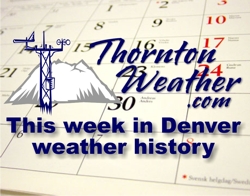
June typically is a very eventful weather month and looking back at this week in Denver weather history that is clearly seen. Among the more noteworthy items are the 2002 Hayman Fire, a 1965 flood that damaged dozens of bridges in the Denver area and the infamous tornadoes in 1988 that struck near downtown Denver.
11-14
In 1999…damage from several hailstorms in and near metro Denver totaled 35 million dollars. About 17.5 million dollars was from automobile claims with another 17.5 million in homeowner claims. The areas hardest hit by the storms included Castle Rock…Commerce City…Evergreen… And Golden.
12-17
In 2000…two large wildfires developed in the Front Range foothills as careless campers and very dry conditions proved to be a dangerous combination. Strong winds gusting in excess of 60 mph on the 13th fanned the flames… Spreading both wildfires out of control. Winds gusted to 78 mph atop Niwot Ridge near the Continental Divide west of Boulder. The hi meadows wildfire…about 35 miles southwest of Denver…consumed nearly 11 thousand acres and 80 structures…mostly high priced homes. The bobcat wildfire…located about 12 miles southwest of Fort Collins… Consumed nearly 11 thousand acres and 22 structures. Late on the 16th…a strong cold front moved south over the great plains into northeastern Colorado. Low level upslope conditions developed in the wake of the front…producing 2 to 4 inches of snowfall overnight at elevations above 8 thousand feet. Firefighters were able to contain both fires shortly thereafter.
13
In 1956…a microburst caused a brief wind gust to 59 mph at Stapleton Airport.
In 1957…an unconfirmed tornado appeared to touch the ground in the vicinity of Franktown. No damage was reported from the twister.
In 1968…a violent gust of wind…possibly associated with a thunderstorm…caused 75 hundred dollars damage in Boulder.
In 1973…hail…1/2 to 3/4 inch in diameter…fell over Lakewood. Flash flooding occurred in west Denver from the same storm.
In 1974…a thunderstorm wind gust to 64 mph was recorded at Stapleton International Airport.
In 1977…hail the size of table tennis balls…1 1/2 inches in diameter…was reported in Boulder.
In 1981…large hail to golf ball size fell in Denver… Northglenn…and Brighton. Hail as large as baseballs was reported in Federal Heights.
In 1984…one of the worst hailstorms ever experienced in metro Denver struck the northwestern suburbs of Arvada…Wheat Ridge…and Lakewood…but large hail also fell in Golden… Southeast Denver…and Aurora. Homes and other buildings sustained around 200 million dollars in damage. Thousands of cars were battered by giant hailstones…and total damage to vehicles was estimated at 150 million dollars. In some areas…golf ball size hail fell continuously for 30 to 40 minutes. Some places were pelted with a few stones as large as grapefruits! Roofs on thousands of structures were severely damaged. Uncounted car windshields were broken; two-thirds of Arvada’s police cars were rendered inoperable. Torrential rains…with as much as 4.75 inches in Lakewood clogged drains and caused widespread damage from flooding. In some places hail was washed into drifts several feet deep. About 20 people were injured by the giant hailstones. One couple was hospitalized. A woman drowned when she was trapped under a trailer by high water. Only pea size hail fell at Stapleton International Airport.
In 1988…2 inch hail fell in Parker. Soft hail 1 inch in diameter fell at the mouth of turkey creek canyon 5 miles southeast of Morrison. Hail between 1 inch and 1 3/4 inches fell at both Bennett and Strasburg. A tornado touched down briefly at Strasburg. A brief funnel cloud was sighted by national weather service observers 15 miles southwest of Stapleton International Airport.
In 1991…a Boulder man was injured when struck by lightning while in a tent. He received only minor burns.
In 1997…lightning struck a home in Denver. The extent of the damage was unknown. A home in Littleton was also struck. The house caught fire…but the extent of the damage was not known.
In 1998…a strong mountain wave produced a brief period of high winds along the Front Range. A small building atop squaw pass west of Denver was blown down. Tree limbs were downed across metro Denver. Peak wind gusts included: 80 mph on squaw pass…69 mph at Jefferson County Airport near Broomfield…and 60 mph in Westminster and at the National Center for Atmospheric Research in Boulder. West-northwest winds gusted to 51 mph at Denver International Airport.
In 2001…high winds developed briefly in Boulder County. A peak wind gust to 76 mph was recorded at the National Center for Atmospheric Research atop the mesa in Boulder. A wind gust to 72 mph was recorded at southern hills middle school in Boulder. Lightning started a small fire…which damaged the roof of a house in Greenwood Village.
In 2009…severe thunderstorms produced hail up to one inch in diameter near Arvada and byers…as well as 7 miles north-northwest of Front Range airport near watkins.
Continue reading June 13 to June 19 – This week in Denver weather history
